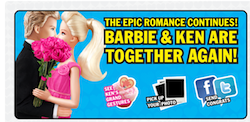 The news shocked the world on Valentine’s Day of 2004: America’s favorite couple was breaking up after 43 years of going steady. The split even made the evening news. There was public outcry. How could this happen to the perfect pair? Where did Barbie and Ken go wrong?!
The news shocked the world on Valentine’s Day of 2004: America’s favorite couple was breaking up after 43 years of going steady. The split even made the evening news. There was public outcry. How could this happen to the perfect pair? Where did Barbie and Ken go wrong?!
Luckily, thanks to some creative marketing, it looks like there is new hope for these star-crossed lovers.
Fast forward to 2011: seven years to the day of their infamous breakup, the dolls are back together, and their recent engagement — Barbie said yes in Times Square on Valentines Day — has been accompanied by a massive, organic, and, frankly, brilliant interactive web campaign.
With these established doll brands, the key was creating buzz. Being a legacy brand had caught up with the couple: enthusiasm had faded and the marketing had gotten stale. The biggest challenge for Mattel was in resurrecting Barbie’s ailing counterpart, Ken, who’s sales had lagged even further behind Barbie’s.
To make Ken relevant, Mattel created an active digital presence for the doll on all social media channels available: Twitter, Facebook, and even Foursquare.
Sure enough, social media made these plastic dolls come to life. Fans got updates about the daily lives of Ken and Barbie in the same way they would with celebrities such as Kim Kardashian and Justin Bieber. The dolls were humanized.
Fans have not only been able to follow this love story — they have also been a part of it. Through voting via text message and social media, fans ultimately decided whether or not Barbie and Ken got back together, with the “Love-O-Meter” on the Barbie and Ken website pointing at “Give Him a Chance!” on Valentines Day 2011.
Consumer engagement continued on after they reconnected. Using Facebook and Twitter, fans sent messages of congratulations to the dolls. This was a particularly wise move on Mattel’s part. The brand clearly understands that social media can’t be a series of campaigns with clearly defined start and end dates — it has got to be a constant and ongoing process.
Ken now has over 40,000 Facebook fans and 8,000 Twitter followers and Barbie now has over 1.7 million Facebook fans and 35,000 Twitter followers. More importantly, for the first time since ’04, the 50 year old toys are back in the zeitgeist.
The fact that Mattel made such content interactive led to a sense of investment and involvement on the part of the consumer. Instead of discounts or new accessories — business as usual — they took a creative leap towards personified posts from the characters themselves, and users responded en masse. Tweets, Facebook posts and more showed crowds interacting with Barbie and Ken as if they were real. These are intimate, personal connections with the brand, being formed every day, in real time.
Barbie and Ken’s relationship — with each other and their fans — now seems stronger than ever. And most crucially in this digital age, it’s Facebook official: Barbie has changed her status to “in a relationship.”

